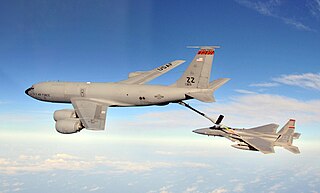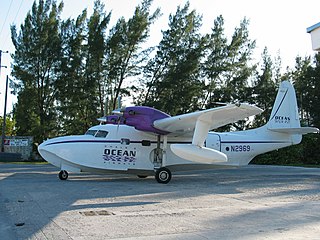
The Boeing KC-135 Stratotanker is an American military aerial refueling tanker aircraft that was developed from the Boeing 367-80 prototype, alongside the Boeing 707 airliner. It has a narrower fuselage and is shorter than the 707. Boeing gave the aircraft the internal designation of Model 717. The KC-135 was the United States Air Force's first jet-powered refueling tanker and replaced the KC-97 Stratofreighter. The KC-135 was initially tasked with refueling strategic bombers, but it was used extensively in the Vietnam War and later conflicts such as Operation Desert Storm to extend the range and endurance of US tactical fighters and bombers.

Trans World Airlines Flight 800 (TWA800) was a Boeing 747-100 that exploded and crashed into the Atlantic Ocean near East Moriches, New York, on July 17, 1996, at about 8:31 pm. EDT, 12 minutes after takeoff from John F. Kennedy International Airport, on a scheduled international passenger flight to Rome, with a stopover in Paris. All 230 people on board died in the crash; it is the third-deadliest aviation accident in U.S. history. Accident investigators from the National Transportation Safety Board (NTSB) traveled to the scene, arriving the following morning amid speculation that a terrorist attack was the cause of the crash. Consequently, the Federal Bureau of Investigation (FBI) and New York Police Department Joint Terrorism Task Force (JTTF) initiated a parallel criminal investigation. Sixteen months later, the JTTF announced that no evidence of a criminal act had been found and closed its active investigation.

On 25 July 2000, Air France Flight 4590, a Concorde passenger jet on an international charter flight from Paris to New York, crashed shortly after takeoff, killing all 109 people on board and four on the ground. It was the only fatal Concorde accident during its 27-year operational history.

The Grumman X-29 was an American experimental aircraft that tested a forward-swept wing, canard control surfaces, and other novel aircraft technologies. The X-29 was developed by Grumman, and the two built were flown by NASA and the United States Air Force. The aerodynamic instability of the X-29's airframe required the use of computerized fly-by-wire control. Composite materials were used to control the aeroelastic divergent twisting experienced by forward-swept wings, and to reduce weight. The aircraft first flew in 1984, and two X-29s were flight tested through 1991.
Chalk's International Airlines, formerly Chalk's Ocean Airways, was an airline with its headquarters on the grounds of Fort Lauderdale-Hollywood International Airport in unincorporated Broward County, Florida near Fort Lauderdale. It operated scheduled seaplane services to the Bahamas. Its main base was Miami Seaplane Base (MPB) until 2001, with a hub at Fort Lauderdale-Hollywood International Airport. On September 30, 2007, the United States Department of Transportation revoked the flying charter for the airline, and later that year, the airline ceased operations.

A fuel tank is a safe container for flammable fluids, often gasoline or diesel fuel. Though any storage tank for fuel may be so called, the term is typically applied to part of an engine system in which the fuel is stored and propelled or released into an engine. Fuel tanks range in size and complexity from the small plastic tank of a butane lighter to the multi-chambered cryogenic Space Shuttle external tank.

Air Transat Flight 236 was a transatlantic flight bound for Lisbon, Portugal, from Toronto, Canada, that lost all engine power while flying over the Atlantic Ocean on August 24, 2001. The Airbus A330 ran out of fuel due to a fuel leak caused by improper maintenance. Captain Robert Piché, 48, an experienced glider pilot, and First Officer Dirk DeJager, 28, glided the plane to a successful emergency landing in the Azores, saving all 306 people on board. Most of the passengers on the flight were Canadians visiting Europe or Portuguese expatriates returning to visit family in Portugal. This was also the longest passenger aircraft glide without engines, gliding for nearly 75 miles or 121 kilometres. Following this unusual aviation accident, this aircraft was nicknamed the "Azores Glider".

The Grumman G-73 Mallard is a medium, twin-engined amphibious aircraft. Many have been modified by replacing the original Pratt & Whitney Wasp H radial engines with modern turboprop engines. Manufactured from 1946 to 1951, production ended when Grumman's larger SA-16 Albatross was introduced.

Pan Am Flight 214 was a scheduled flight of Pan American World Airways from Isla Verde International Airport in San Juan, Puerto Rico, to Friendship Airport in Baltimore and Philadelphia International Airport. On December 8, 1963, the Boeing 707-121 serving the flight crashed near Elkton, Maryland, while flying from Baltimore to Philadelphia, after being hit by lightning. All 81 occupants of the plane were killed. The crash was Pan Am's first fatal accident with the 707, which it had introduced to its fleet five years earlier.

A self-sealing fuel tank is a type of fuel tank, typically used in aircraft fuel tanks or fuel bladders, that prevents them from leaking fuel and igniting after being damaged.

The Beechcraft 1900 is a twin-engine turboprop regional airliner manufactured by Beechcraft. It is also used as a freight aircraft and corporate transport, and by several governmental and military organizations. With customers favoring larger regional jets, Raytheon ended production in October 2002.

The Grumman Gulfstream I is a twin-turboprop business aircraft. It first flew on August 14, 1958.

Chalk's Ocean Airways Flight 101 was an aircraft crash that occurred off Miami Beach, Florida, in the United States on December 19, 2005. All 18 passengers and the 2 crew members on board the 1947 Grumman G-73T Turbine Mallard died in the crash, which was attributed to metal fatigue on the starboard wing resulting in separation of the wing from the fuselage.

In a fixed-wing aircraft, the spar is often the main structural member of the wing, running spanwise at right angles to the fuselage. The spar carries flight loads and the weight of the wings while on the ground. Other structural and forming members such as ribs may be attached to the spar or spars, with stressed skin construction also sharing the loads where it is used. There may be more than one spar in a wing or none at all. Where a single spar carries most of the force, it is known as the main spar.

Sealant is a substance used to block the passage of fluids through openings in materials, a type of mechanical seal. In building construction sealant is sometimes synonymous with caulking and also serve the purposes of blocking dust, sound and heat transmission. Sealants may be weak or strong, flexible or rigid, permanent or temporary. Sealants are not adhesives but some have adhesive qualities and are called adhesive-sealants or structural sealants.

China Airlines Flight 120 was a regularly scheduled flight from Taiwan Taoyuan International Airport in Taoyuan County, Taiwan to Naha Airport in Okinawa, Japan. On August 20, 2007, the Boeing 737-800 aircraft operating the flight caught fire and exploded after landing and taxiing to the gate area at Naha Airport. Four people—three from the aircraft and one ground crew—sustained injuries in the accident. The fire had been caused by a loose bolt puncturing a fuel tank.

British Airways Flight 38 was a scheduled international passenger flight from Beijing Capital International Airport in Beijing, China, to London Heathrow Airport in London, United Kingdom, an 8,100-kilometre trip. On 17 January 2008, the Boeing 777-200ER aircraft operating the flight crashed just short of the runway while landing at Heathrow. No fatalities occurred; of the 152 people on board, 47 sustained injuries, one serious. It was the first time in the aircraft type's history that a Boeing 777 was declared a hull loss, and subsequently written off.
Miami Seaplane Base is a public-use seaplane base located 2 miles (3.2 km) east of the central business district of Miami on Watson Island in Miami-Dade County, Florida, United States.

Aircraft fuel tanks are a major component of aircraft fuel systems. They can be classified into internal or external fuel tanks and can be further classified by method of construction or intended use. Safety aspects of aircraft fuel tanks were examined during the investigation of the 1996 TWA Flight 800 in-flight explosion accident.

On October 29, 2015, Dynamic Airways Flight 405, a Boeing 767 on a scheduled passenger service from Fort Lauderdale, Florida, to Caracas, Venezuela, suffered a fire while taxiing for departure. All 101 passengers and crew evacuated the aircraft and survived, but twenty-two of them were injured.















